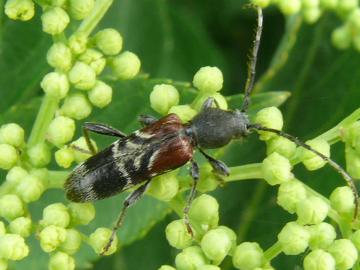Species Account for Anaglyptus mysticus
PLEASE NOTE, many records in this group are not yet available
Anaglyptus mysticus (Linnaeus, 1758)
Coleoptera: Cerambycidae

Reproduction for study and non-profit use permitted, all other rights reserved.
Taxonomic group: beetles (Coleoptera) - Available county data
View time series maps for Anaglyptus mysticus
member log-on for taxon report
Status: Nb
Essex RDB: Listed
Saproxylic species
Images
upload a new image
Essex Red Data List comment
Essex Post-1969 record/s; VC18 1970-on record/s; VC19 1970-on record/s.
Species text
Anaglyptus mysticus is a spectacular grey and red/brown longhorn beetle found in woodland, scrub and hedgerows which is widespread, but local in England and Wales. It breeds in dry dead wood of branches and trunks of various species of broad leaved trees as well as scrub such as hawthorn and holly. It apparently particularly favours very dry timber, often that scorched by fire, taking a very long time for the larvae to mature. Both fallen and standing dead timber, especially with the bark attached, should be retained. Gaps in the age structure of the tree and shrub population should be identified and the continuity of the appropriate dead wood habitat ensured by suitable planting. Nectar sources such as hawthorn, umbellifers and composite herbs may be particularly important for this species (Hyman & Parsons, 1992). References
Habitats
Recorded management for locations with Anaglyptus mysticus
Recorded substrate and hydrology for locations with Anaglyptus mysticus
Why not join the Club, register and add a new species page
Interpretation of distribution maps




















